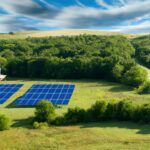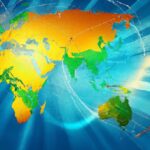Climate change is having far-reaching effects on Earth’s ecosystems, posing immense challenges to our planet’s biodiversity and human societies. Rising global temperatures and changing weather patterns are causing drastic shifts in ecosystems and disrupting natural processes. Sea levels are rising, resulting in coastal erosion and increased vulnerability to flooding. Extreme weather events, such as hurricanes and heatwaves, are becoming more frequent and intense. Additionally, climate change is altering precipitation patterns, leading to droughts in some regions and heavy rainfall in others. These changes are not only endangering countless species and habitats but also impacting agriculture, water resources, and human health, making urgent action to mitigate and adapt to climate change crucial.
Climate change refers to long-term shifts in weather patterns and global temperatures caused by human activities, primarily the burning of fossil fuels and deforestation. These activities release large amounts of greenhouse gases, such as carbon dioxide, into the atmosphere, trapping heat and leading to a range of negative impacts. The effects of climate change are becoming increasingly evident and pose significant challenges to ecosystems, human health, and socio-economic development.
One of the most noticeable effects of climate change is the rise in global temperatures. As a result, heatwaves have become more frequent and intense, leading to increased heat-related illnesses and deaths. Higher temperatures also contribute to the melting of ice caps and glaciers, causing sea levels to rise. Coastal communities are at risk of flooding and erosion, while inhabitants of low-lying islands face the possibility of complete submersion.
Changes in precipitation patterns are another consequence of climate change. Some regions are experiencing more frequent and severe droughts, leading to water shortages and reduced agricultural productivity. Conversely, other areas are seeing increased rainfall and severe storms, which can result in flash flooding, landslides, and property damage.
Climate change also affects natural ecosystems and biodiversity. Many species struggle to adapt to rapidly changing conditions, leading to habitat loss and increased extinction rates. Coral reefs, for example, are highly susceptible to rising ocean temperatures and are suffering from bleaching events, leaving marine biodiversity at risk.
Moreover, climate change has economic implications. Extreme weather events disrupt supply chains and agricultural production, leading to lower yields and increased food prices. Furthermore, industries such as tourism and agriculture, which rely heavily on stable climate conditions, are adversely affected.
In conclusion, climate change poses a range of detrimental effects to the environment, human health, and the economy. Urgent action is required at local, national, and international levels to mitigate greenhouse gas emissions, adapt to changing conditions, and promote sustainable practices. The long-term well-being of the planet and its inhabitants depends on our ability to address and mitigate the effects of climate change.
Causes of climate change
Climate change is primarily caused by a combination of natural factors and human activities. It is essential to understand the different causes that contribute to this global issue in order to address and mitigate its impacts effectively. The following are the key causes of climate change.
1. Greenhouse gas emissions: The primary driver of climate change is the excessive release of greenhouse gases (GHGs) into the atmosphere. Human activities, such as the burning of fossil fuels (coal, oil, and natural gas) for energy, industrial processes, and deforestation, have significantly increased GHG concentrations. These gases, including carbon dioxide (CO2), methane (CH4), and nitrous oxide (N2O), trap heat within the Earth’s atmosphere, leading to the greenhouse effect and subsequent global warming.
2. Deforestation: The removal of forests at an alarming rate contributes to climate change. Trees play a vital role in absorbing CO2 and acting as carbon sinks. As forests are cleared for agricultural expansion, logging, and urbanization, the captured carbon is released back into the atmosphere, intensifying the greenhouse effect. Deforestation also reduces the Earth’s capacity to absorb CO2, exacerbating climate change further.
3. Industrial activities: Industrial processes, including manufacturing, mining, and cement production, release large amounts of GHGs, particularly CO2 and methane. Fossil fuel combustion in industries accounts for a significant portion of global CO2 emissions. Additionally, the extraction and production of non-renewable resources contribute to deforestation and habitat destruction, further amplifying climate change.
4. Agricultural practices: The agricultural sector plays a critical role in climate change due to practices such as livestock rearing and rice cultivation. Livestock farming, especially cattle, produces substantial amounts of CH4, a potent greenhouse gas. Moreover, rice paddy fields generate significant amounts of methane through anaerobic decomposition. The use of synthetic fertilizers in agriculture also leads to increased emissions of N2O, another potent GHG.
5. Land use changes: Land use changes, including urbanization, expansion of agricultural land, and infrastructure development, disrupt natural ecosystems and alter the Earth’s surface. These changes contribute to climate change by releasing CO2 through deforestation and increasing the Earth’s reflectivity or albedo, thereby affecting the balance of solar radiation.
6. Loss of biodiversity: Climate change and the loss of biodiversity are interconnected. The degradation of ecosystems, including coral reefs and forests, reduces their ability to absorb CO2 and regulate the climate. Conversely, climate change affects various species through habitat alteration, temperature changes, and disrupted ecological relationships, leading to further biodiversity loss.
In conclusion, climate change is primarily caused by human activities, specifically the excessive emission of greenhouse gases from burning fossil fuels, deforestation, industrial processes, agricultural practices, land use changes, and loss of biodiversity. Recognizing and understanding these causes is crucial for formulating comprehensive strategies to mitigate climate change, reduce emissions, and promote sustainable practices in order to safeguard our planet’s future.
Impacts on ecosystems
Impacts on ecosystems:
Climate change is having significant impacts on ecosystems around the world, with far-reaching consequences for biodiversity, species interactions, and the overall functioning of ecosystems. These impacts are resulting in both direct and indirect changes that can disrupt ecological processes and alter the distribution and abundance of species.
One of the most immediate and visible impacts of climate change on ecosystems is the alteration of habitat conditions. Rising temperatures, changing precipitation patterns, and shifts in seasonal timing can all affect the availability and suitability of habitats for different species. This can lead to shifts in the geographical ranges of species, changes in migration patterns, and in some cases, local extinctions.
Another key impact is that climate change can disrupt species interactions, such as predator-prey dynamics and mutualistic relationships. As temperatures change, the timing of important events, such as flowering and nesting, can become mismatched between species that rely on each other. For example, if the flowering of a plant species that serves as a key food source for a pollinator is no longer synchronized with the arrival of the pollinator, both the plant and the pollinator may suffer declines in population size.
Climate change can also have indirect effects on ecosystems through changes in disturbance regimes. For example, altered rainfall patterns and increased frequency of extreme weather events can lead to more frequent and intense wildfires, which can have devastating impacts on terrestrial ecosystems. Additionally, warmer temperatures can contribute to the spread of pests and diseases, further stressing ecosystems.
Furthermore, climate change can also affect the availability and quality of resources within ecosystems. Changes in precipitation patterns can lead to droughts or flooding, which can impact the availability of water for plants and animals. This can result in reduced vegetation cover, changes in plant community composition, and ultimately, alterations to the entire food web.
Overall, the impacts of climate change on ecosystems are complex and multifaceted. From shifts in species distributions to changes in species interactions and altered disturbance regimes, the consequences of climate change can be profound. These impacts can disrupt ecological processes, decrease biodiversity, and compromise the ability of ecosystems to provide vital services such as clean water, air, and food. It is essential to address and mitigate these impacts in order to protect and restore ecosystems for future generations.
Rising sea levels
Rising sea levels are one of the most significant effects of climate change, posing a serious threat to coastal regions and low-lying areas around the world. As global temperatures continue to rise, glaciers and ice caps melt, causing the volume of seawater to expand and leading to the inundation of coastal areas.
One of the primary contributors to rising sea levels is the melting of polar ice. The melting of ice sheets in Greenland and Antarctica, as well as the melting of glaciers in mountainous regions, leads to the introduction of large volumes of water into the oceans. This, in turn, causes the sea level to rise gradually over time.
Additionally, thermal expansion plays a significant role in the rising sea levels. As the Earth’s atmosphere and oceans warm, seawater expands, occupying more space and resulting in an increase in overall sea level. The expansion of seawater is influenced by the higher temperatures of the ocean’s surface and the absorption of heat by the water.
The consequences of rising sea levels are numerous and wide-ranging. Coastal erosion is a major concern, as higher water levels erode beaches and cliffs, leading to the loss of land and property. It also threatens vital coastal infrastructure, including roads, airports, power plants, and sewage treatment facilities, all of which are at risk of becoming submerged.
Another serious consequence is the increased risk of flooding. As sea levels rise, storm surges and tidal flooding become more severe and more frequent. This poses significant threats to coastal communities, particularly during extreme weather events such as hurricanes or typhoons. Inland areas located along rivers or estuaries are also at risk of flooding due to higher sea levels.
The impact of rising sea levels extends beyond immediate physical damage. It leads to the salinization of freshwater sources, as saltwater infiltrates underground aquifers and contaminates drinking water supplies. This poses a threat to both human populations and delicate ecosystems that rely on freshwater resources for survival.
Moreover, rising sea levels have significant implications for biodiversity and ecosystem health. Coastal habitats, such as mangroves, salt marshes, and coral reefs, face increased stress as the higher water levels encroach upon their habitats. These ecosystems provide vital services such as coastal protection, habitat for marine life, and carbon sequestration, and their disruption could have far-reaching consequences.
In conclusion, rising sea levels are a direct consequence of climate change with potentially catastrophic consequences. The melting of polar ice and thermal expansion of seawater are the primary contributors to this phenomenon. The resulting risks include coastal erosion, increased flooding, freshwater contamination, and the degradation of important coastal habitats. Urgent action is needed to mitigate climate change and prevent further sea level rise, protecting vulnerable coastal regions and the ecosystems they support.
Extreme weather events
Extreme weather events refer to the occurrence of severe and unpredictable weather conditions that deviate from the normal climate patterns in a specific region. These events include, but are not limited to, hurricanes, tornadoes, floods, droughts, heatwaves, blizzards, and heavy rainfall.
Hurricanes are intense tropical cyclones characterized by low-pressure systems accompanied by strong winds and heavy rains. They form over warm ocean waters and can cause widespread damage to coastal areas, resulting in flooding, destruction of infrastructure, and loss of life.
Tornadoes are violent and rotating columns of air that extend from a cumulonimbus cloud to the ground. They are known for their destructive power, capable of demolishing buildings, uprooting trees, and causing fatalities within a matter of minutes. Tornadoes often occur in regions with unstable atmospheric conditions.
Floods, caused by excessive rainfall or the overflow of rivers and lakes, can lead to the submergence of land, displacement of people, destruction of crops, and contamination of water sources. Flash floods can occur suddenly and without warning, trapping individuals and causing considerable damage to infrastructure.
Droughts are prolonged periods of significantly reduced rainfall that result in water scarcity and parched landscapes. They can have severe impacts on agriculture, leading to crop failure, scarcity of drinking water, and loss of livestock. Droughts can also increase the risk of wildfires due to the dry conditions.
Heatwaves, characterized by abnormally hot weather over an extended period, can have serious consequences for human health, especially for vulnerable populations like the elderly and children. Heatwaves can lead to heat exhaustion, heatstroke, and increased mortality rates. They can also put strain on energy systems as the demand for cooling increases.
Blizzards, characterized by heavy snowfall, strong winds, and low visibility, can disrupt transportation, damage infrastructure, and pose risks to human safety. Falling snow can accumulate and create hazardous conditions, impeding travel and causing accidents.
Heavy rainfall events can result in flash floods, landslides, and mudslides. Excessive rainfall within a short period can overwhelm drainage systems and cause water levels to rise rapidly, leading to extensive damage.
In conclusion, extreme weather events have the potential to cause significant disruptions to ecosystems, economies, and human life. These events are becoming more frequent and intense due to climate change. Understanding the impacts and dynamics of extreme weather events is crucial for developing strategies to mitigate their effects and adapt to a changing climate.
Mitigation and adaptation strategies
Mitigation and adaptation strategies are vital approaches in combating the impacts of climate change. These strategies aim to reduce the emission of greenhouse gases and minimize the negative effects on the environment and society. Here are some important points regarding mitigation and adaptation strategies:
Mitigation Strategies:
1. Renewable Energy Transition: Encouraging the adoption of renewable energy sources such as solar, wind, and hydropower is crucial in reducing greenhouse gas emissions. This transition can be achieved through supportive policies, financial incentives, and the development of clean energy infrastructure.
2. Energy Efficiency: Implementing energy-efficient practices in industries, households, and transportation sectors can significantly decrease energy consumption and subsequently reduce greenhouse gas emissions. This can be achieved by using energy-efficient appliances, improving insulation, and promoting sustainable transportation methods.
3. Afforestation and Reforestation: Planting trees and restoring forests help absorb carbon dioxide from the atmosphere, acting as carbon sinks. These actions also promote biodiversity, conserve water, and prevent soil erosion.
4. Carbon Capture and Storage (CCS): CCS technologies capture carbon dioxide emitted from power plants and industrial processes, preventing it from entering the atmosphere. The captured CO2 is then stored underground or utilized in industrial processes.
Adaptation Strategies:
1. Enhancing Infrastructure Resilience: Adapting infrastructure to withstand the potential effects of climate change, such as rising sea levels, extreme weather events, and increased temperatures, is crucial. This includes constructing flood barriers, elevating buildings, and improving drainage systems.
2. Water Resource Management: Developing sustainable water management practices is essential for adapting to the changing climate. This involves improving water storage, implementing efficient irrigation systems, and promoting water conservation measures.
3. Agriculture and Food Security: Adapting agricultural practices to changing climatic conditions is vital for ensuring food security. This can involve implementing drought-resistant crop varieties, improving irrigation techniques, and promoting sustainable farming practices.
4. Public Health Preparedness: Climate change can have significant impacts on public health, including the spread of diseases and heat-related illnesses. Adaptation strategies in this area involve strengthening healthcare systems, developing early warning systems, and promoting public awareness and education.
5. Ecosystem Conservation and Restoration: Protecting and restoring ecosystems are crucial for adaptation efforts. Healthy ecosystems play a vital role in regulating natural processes and providing protective services against climate-related impacts, such as coastal erosion and natural disasters.
Mitigation and adaptation strategies are not isolated efforts but rather should be integrated across all sectors to achieve effective results. It is important for governments, businesses, communities, and individuals to work collaboratively to implement these strategies and address the challenges associated with climate change.













